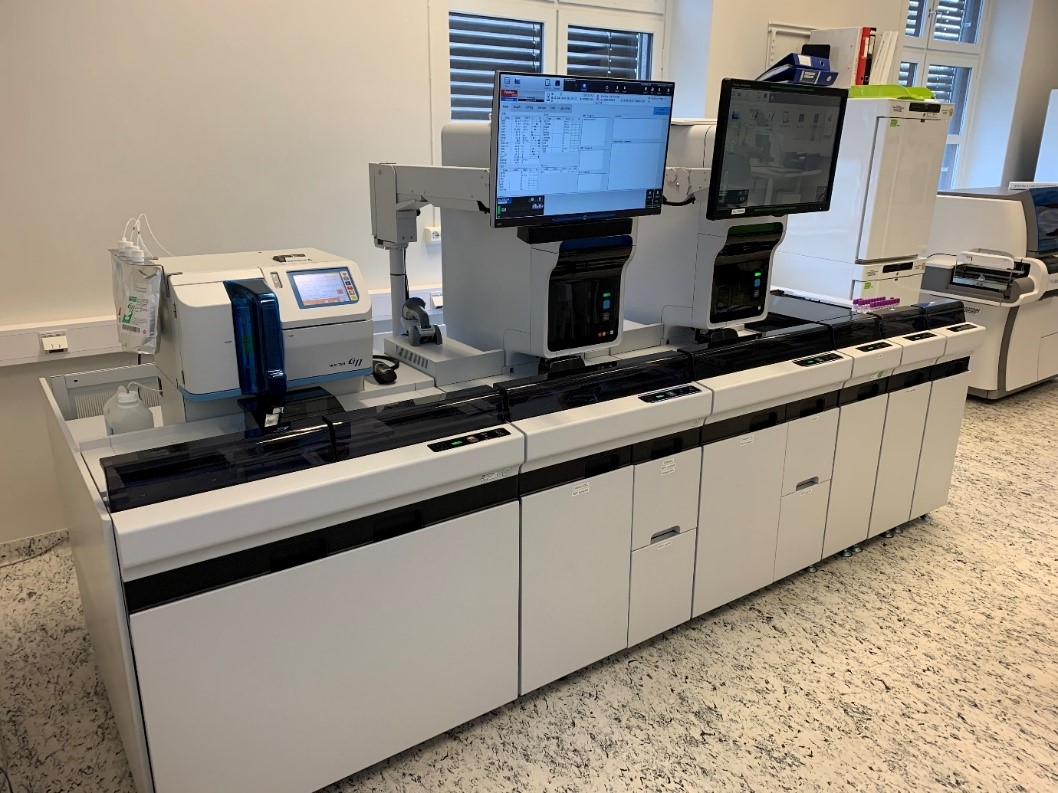Improving Workflow Excellence with the Tosoh G11
Lovisenberg Diaconal Hospital, Norway
An interview with Leading Biomedical Scientist Hanne E. Lunde and May-Linn S. Sterud, Biomedical Scientist.
Hanne E. Lunde, the leading biomedical scientist in Haematology, has worked at the Lovisenberg Laboratory for 17 years. The past 13 years she has worked very closely with May-Linn Sterud, one of the superusers in the haematology team.
Several changes have occurred throughout the years, where among others, the most important is the increased volume of testing. Contributing factors are the increase in the elderly population, increasing immigration rates – and finally, an increasing number of tests due to the adoption of personalised medicine.
The Lovisenberg Laboratory has been a Sysmex customer for decades and developed from solutions with low automation/manual analysers and as technological advancements were introduced, the laboratory has gained experience in the consolidation, integration and automation of the instruments. As a result, Lovisenberg Laboratory has been able to promote staff to higher-value responsibilities and save money in tube costs and – all of this while increasing clinicians' trust in the laboratory to support excellence in patient diagnostics and care.
In 2018, due to the continuous increase in the number of samples, the laboratory implemented the new XN-9000 automation line consisting of an XN-10 and XN-20, thus to automate all haematology samples.
The Sysmex XN-9000 system delivers extensive automation and workflow optimisation and the possibility for customisation and traceability. The efficiency gained empowered the staff to think differently – “would it be possible to automate the HbA1c assays?”
About Lovisenberg Diaconal Hospital

Lovisenberg Diaconal Hospital was founded in 1868 by the pioneer Cathinka Guldberg, the first trained nurse in the Norwegian medical history. Her efforts and foresight in competence and care helped create the foundations for the modern practices in use at the hospital today.
Lovisenberg Diaconal Hospital is a local hospital providing medical services for the inhabitants of four city districts in Oslo: Sagene, Gamle Oslo, Grünerløkka, and St.Hanshaugen, including the centrum area accounting for approximately 25 percent of the city's population.
In addition, psychiatric services are offered to several other city boroughs and the hospice, Lovisenberg Relief & Life Support offers palliative care. The departments have a wide range of specialists, and the health care offered is managed in close co-operation with other hospitals and health service providers in Oslo. The hospital is owned by the private deaconess foundations, Diakonissehuset Lovisenberg and Diakonova.
It operates within the framework of public health, with a long-term contract with the Southeastern Norway Regional Health Authority. The hospital has 228 beds, with approximately 1.300 staff and an extensive orthopaedic out-patient facility, where almost 1.000 hip and knee replacements are performed annually. The hospital has a modern X-ray department, a clinical laboratory, and a pharmacy.
Historically, the HbA1c assays were processed by the coagulation team using HPLC technology as a stand-alone instrument; a time-consuming procedure as several tasks had to be handled manually. First and foremost, there was a need for two EDTA tubes, one for HbA1c and one for the rest of the haematological parameters. One tube was handed over to the coagulation department and the other tube was handed to the haematology department. Reading of the results were performed manually, and all the chromatograms had to be manually interpreted and validated before released and electronically transmitted to the LIS.
With the arrival of the XN-line, a new possibility saw the light of day – with the dream and realisation of automation, the HbA1c assay was moved to the haematology team.
“One of the major advancements by using the Tosoh G11,” Hanne explains, “is that we have almost eliminated the hands-on time and we have very little manual handling of samples.”
Lovisenberg Laboratory at a glance:
|
Before the move to the Tosoh G11, Lovisenberg only analysed HbA1c at daytime from Monday-Friday. Now they have the possibility to analyse HbA1c samples 24/7 and the high stability of the Tosoh G11 analyser makes it a perfect automation solution.
Hanne E. Lunde elaborates further, “One of the greatest improvements we have achieved is during the evening and night shift. As there are fewer people at work, we can focus on other tasks rather than moving samples from one analyser to another and with the Extended IPU we have integrated the HbA1c validation with haematology validation. This means that all results can be validated from the same place in the laboratory and we don’t have to walk to different analysers to validate results. Another huge benefit is that all normal chromatograms are autovalidated, which means that we only need to interpret and validate abnormal chromatograms”.
In Norway more than 245.000 people are diagnosed with diabetes (217.000 have type 2 diabetes and 28.000 have type 1 diabetes). Every year approximately 15.000-16.000 people are diagnosed with diabetes. |
Installation
The Tosoh G11 was installed in April 2020 in the middle of the global pandemic. The Norwegian Sysmex team took care of everything from the initial installation, the training of the staff in the laboratory, of course observing the distancing guidelines due to the pandemic, while the rule set in the Extended IPU was conducted online via Microsoft® Teams. All went exceptionally well and Hanne and May-Linn were able to handle the internal training themselves with support from the Sysmex team. As Hanne said, “Every laboratory technician in our lab is used to working with Sysmex, HPLC and the Extended IPU. All in all, it was a very smooth and easy transition to the new equipment.”
Verification
To ensure that HbA1c results are comparable with the previous method, a verification process was performed towards the former instrument. The verification process lasted a week during the summer period. As the Tosoh G11 can detect different haemoglobin variants (HbA, HbD, HbS, and HbE), which are not seen on a regular basis, the laboratory requested samples from Oslo University Hospital to verify these as well.

Haemoglobinopathies:The incidence of haemoglobinopathies (thalassaemia and haemoglobin variants) is more frequent than previously thought and is increasing in Norway. Typical for most haemoglobin variants is that they cause a decreasing erythrocyte life expectancy, resulting in lower HbA1c results than corresponding to the average glucose concentration in plasma. Therefore, HbA1c cannot be used diagnostically in patients with hemoglobinopathy1. (ref) |
Diagnosing and monitoring the treatment of people with diabetes takes up considerable resources in laboratories. HbA1c has been the mainstay of monitoring glycaemic control in people with diabetes for many years. Hanne explains that HPLC assays have been a part of the Lovisenberg Laboratory for the 17 years she has worked there, although several steps were performed manually, which resulted in a very time-consuming process.
Following the installation of the Tosoh G11 analyser connected to the Sysmex automated haematology XN-Series line, the manual sample handling is almost non-existent. When the laboratory receives samples, the samples are loaded in Sysmex racks and then loaded onto the Sysmex automation line. “We don’t have to touch either haematology or HbA1c samples again until they are fully analysed,” says Hanne.
The consolidation of assays in one EDTA tube instead of two has also drastically optimised the preanalytical work.
Added value
|
Workflow improvements after the installation
| Stand-alone HPLC- analyser | After the installation of the integrated system |
| 2 EDTA tubes for every patient | 1 covers all |
| 2 different processing areas in the lab | 1 area |
| Manual handling of tubes | Automation |
| Manual sorting | Automation |
| Manual interpretation of all chromatograms | Automation |
| Manual validation of all results | Automation |
References
[1] Tidsskr Nor Legeforen (2019): Kan pasienten ha talassemi eller en hemoglobinvariant? DOI: 10.4045/tidsskr.19.0121